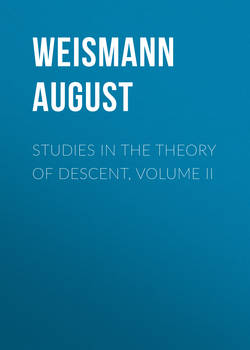Studies in the Theory of Descent, Volume II

Реклама. ООО «ЛитРес», ИНН: 7719571260.
Оглавление
Weismann August. Studies in the Theory of Descent, Volume II
I. Larva and Imago vary in Structure independently of each other
II. Does the Form-relationship of the Larva coincide with that of the Imago?
III. Incongruences in other Orders of Insects
IV. Summary and Conclusion
APPENDIX I.44
APPENDIX II
EXPLANATION OF THE PLATES
Part III. ON THE FINAL CAUSES OF TRANSFORMATION
III. THE TRANSFORMATION OF THE MEXICAN AXOLOTL INTO AMBLYSTOMA
INTRODUCTION
EXPERIMENTS
Postscript
Addendum
IV. ON THE MECHANICAL CONCEPTION OF NATURE
INTRODUCTION
I. Are the Principles of the Selection Theory Mechanical?
II. Mechanism and Teleology
ERRATA
Отрывок из книги
It would be meaningless to assert that the two stages above mentioned were completely independent of one another. It is obvious that the amount of organic and living matter contained in the caterpillar determines the size of the butterfly, and that the quantity of organic matter in the egg must determine the size of the emergent larva. The assertion in the above heading refers only to the structure; but even for this it cannot be taken as signifying an absolute, but only a relative independence, which, however, certainly obtains in a very high degree. Although it is conceivable that every change of structure in the imago may entail a correlative change of structure in the larva, no such cases have as yet been proved; on the contrary, all facts indicate an almost complete independence of the two stages. It is quite different with cases of indirect dependence, such, for example, as are brought about by ‘nurse-breeding.’ This phenomenon is almost completely absent in Lepidoptera, but is found in Diptera, and especially in Hymenoptera in every degree. The larvæ of ichneumons which live in other insects, require (not always, but in most instances) that the female imago should possess a sharp ovipositor, so that in this case also the structure and mode of life of the larva influences the perfect insect. This does not depend, however, on inherent laws of growth (correlation), but on the action of external influences, to which the organism endeavours to adapt itself by natural selection.
I will now let the facts speak for themselves.
.....
Our German S. Carpini shows different characters in the fifth stage. It is true that individual specimens occur which are entirely green without any black, but these are rare; the majority possess a more or less broad black ring encircling the middle of each segment (Pl. VIII., Figs. 78 and 79). Those specimens in which the black ring has become broken up into large or small spots surrounding the base of the warts constitute intermediate forms (Fig. 80). The last stage of the German local form, unlike that of the Genoese local form, is therefore very variable.
The two forms, moreover, do not simply differ in being more or less advanced in phyletic development, but also in several other points. As it is of great theoretical interest to show that a species can develop local differences only in the stage of larva, I will here subjoin the plain facts.
.....